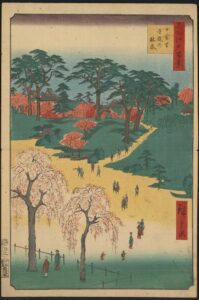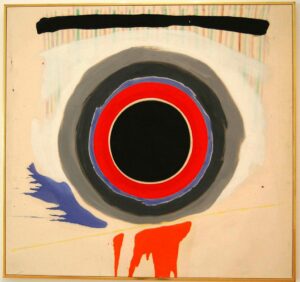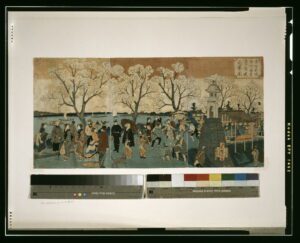The Washington color school is a movement that brought a burst of chromatic brilliance to the art world in the late 1950s and 1960s.
Pioneering a form of abstract expressionism, these artists broke from tradition, immersing viewers in fields of pure color.
We’ll explore how this group, hailing from the nation’s capital, made their indelible mark on modern art.
Get ready to jump into the colorful narratives and techniques that define the Washington color School’s legacy.
Origins Of The Washington Color School
As enthusiasts of art history, we recognize that movements often spring from a combination of cultural shifts and groundbreaking ideas.
The Washington Color School was no exception.
Set against the backdrop of a tumultuous era marked by the Cold War and civil rights movements, artists in Washington D. C. sought a form of expression that broke away from the gestural brushwork of the time.
In the late 1950s, several DC-based artists began experimenting with a new visual language.
This was centered around fields of unbroken color and the interaction of color planes.
Their work emphasized the flatness of the canvas and the purity of color, marking a departure from earlier, more textural abstract art.
Leon Berkowitz, Kenneth Noland, Gene Davis, Howard Mehring, Thomas Downing, Morris Louis, and Sam Gilliam were among the key figures whose styles and techniques defined the movement.
What bound them together was not only their geographic proximity but their shared dedication to color as the primary conveyor of artistic emotion and aesthetic impact.
- Collaborative exhibitions – notably the “Washington Color Painters” show at the Washington Gallery of Modern Art in 1965
- Supportive critics – Clement Greenberg played a pivotal role in championing these artists,
- Innovative techniques – such as Morris Louis’s Magna paint and Noland’s shaped canvases, which influenced the perception of painting as a medium.
The use of strikingly pure, bold color served to command the viewer’s attention and bring them into a space where color interaction created visual impact without the need for figurative references.
Critics and art lovers alike were drawn to the immersive experience offered by the works of the Washington Color School, setting the stage for the movement to earn its place in the annals of modern art.

Key Artists And Influences
We recognize that the tenets of the Washington Color School were embodied by a cohort of artists whose works exemplified this unique approach to visual articulation.
These key figures not only produced groundbreaking art but also influenced the trajectory of the movement through their innovative techniques and expressive use of color.
Leon Berkowitz, a founding member, found his voice in the harmonious blending of hues, creating a sense of cosmic vastness in canvases like Cathedral.
Kenneth Noland’s contributions are distinguishable through his target and chevron motifs – his works, like Beginning, explore the emotive power of color within geometric precision.
Gene Davis introduced a rhythm to the canvas with his vertical stripe patterns, offering a different dynamic in works such as Black Grey Beat.
- Morris Louis – Known for his ‘Veil’ and ‘Unfurled’ series, where the raw canvas played a significant role in capturing flowing rivulets of paint.
- Sam Gilliam – He extended the Color School vocabulary with draped canvases and beveled-edge paintings, challenging conventional boundaries of painting with pieces like Light Depth.
- Thomas Downing – Utilized dots and systematic patterns to engage viewers with spatial complexities, as seen in Grid.
Their influences stretched beyond the canvas, weaving into the fabric of broader conversations in art criticism and history.
They prompted us to consider the nuanced relationships between form, space, and viewer perception.
Critics like Clement Greenberg amplified these conversations, advocating for post – painterly abstraction, a term intimately connected with the ideals of the Washington Color School.
Technical innovations such as acrylic paint and Magna, a clear acrylic resin that allowed for vibrant colors and crisp transitions, supported the visual language of the movement.
These materials were not just mediums but essential components that redefined what was possible in painting.
The Washington Color School’s resonance with Minimalism and post-war American optimism in the arts created a fertile ground for exploration.
As filmmakers, we’re inspired by their audacious use of large color fields – it’s reminiscent of the visual storytelling achieved through color grading and the atmospheric use of lighting in cinema.
Techniques And Styles
The Washington color school artists distinguished themselves through unique methods that redefined the use of color and form.
Stripes, dots, and sharp geometric shapes were hallmarks, with color becoming the main subject of their works.
Their techniques were not confined to traditional brushwork.
Instead, they poured, stained, and soaked paint onto unprimed canvases, allowing the pigments to seep into the fabric.
This approach led to vibrant fields of uninterrupted color, which seemed to merge with the canvas itself.
Artists like Kenneth Noland and Morris Louis developed a radical approach to color and abstraction.
Their works often feature bold, flat planes of color, meticulously arranged to foster a sense of balance and motion.
For instance, Noland’s iconic series Circles and Chevrons showcased how pure color can define space without the need for form or line.
Thomas Downing and Gene Davis pushed boundaries with their repetitive, rhythmic patterns that playfully suggest movement and depth.
In pieces like Davis’s Black Grey Beat, viewers experience how repetition can create visual rhythm as compelling as any musical score.
- Staining – diluting paint to a watercolor-like consistency and applying it to raw canvas,
- Pouring – allowing paint to flow and spread freely across the canvas surface,
- Soaking – employing gravity to guide the paint deep into the canvas threads.
These artists were not simply creating pictures; they were challenging the very nature of painting, asking us to see color and shape in ways that defy conventional interpretations.
Through their meticulous processes and experimental visions, the Washington Color School forged a significant chapter in the history of abstract art.
Impact And Legacy
The Washington Color School’s influence extends beyond the canvases of the 1960s.
We see this movement’s impact in various art forms over the decades, embedding itself into the DNA of abstract art and inspiring generations of artists to explore color as a primary means of expression.
The school spurred a broader appreciation for minimalism and post – painterly abstraction.
Artists were emboldened to experiment with largescale formats and immersive experiences. Morris Louis and Kenneth Noland guided the movement to challenge traditional boundaries, encouraging fresh visual dialogues.
Filmmakers and digital creators have drawn from their concepts, understanding that color, when manipulated expertly, can evoke emotions and narratives without explicit imagery or dialogue.
Sensibilities honed in Washington Color School are evident in the backdrop of modern visual culture, such as:
- Striking color-blocked visuals in advertising,
- Stage designs with monochromatic themes.
The bold use of color in video art installation Gene Davis’s renowned stripes and Thomas Downing’s dotted patterns laid the groundwork for today’s pixelated and digital patterns, underscoring the resonance of their work in technology-driven mediums.
Contemporary artists leveraging digital projectors and video art find roots in the Color School’s principle to merge art with life, permitting nothing to exist in isolation.
Our exploration of the Washington Color School is not about nostalgia but recognizing its modern currency.
As filmmakers, our narrative tools are enriched by the school’s innovations.
We embrace its teachings, understanding that visual storytelling can be similarly transformative – where color and form cue emotional responses and elevate our creative visions without the need for traditional cinematic structures.
What Is Washington Color School In Art – Wrap Up
We’ve explored the groundbreaking realm of the Washington Color School and its profound influence on the art world.

These artists revolutionized the way we perceive and engage with color, leaving an indelible mark on contemporary art.
Their legacy lives on not only in galleries and museums but also in the broader visual landscape that surrounds us.
We recognize the enduring relevance of their vision and the way it continues to inspire new generations to see the world through a vibrant, colorful lens.

Frequently Asked Questions
What Is The Washington Color School?
The Washington Color School refers to a group of painters in the 1950s and 60s in Washington, D.C. , known for their innovative use of color and abstract expression.
Who Were The Notable Artists Of The Washington Color School?
Notable artists of the Washington Color School included Kenneth Noland, Morris Louis, Thomas Downing, and Gene Davis, among others.
What Techniques Did Washington Color School Artists Use?
Artists of this movement employed techniques such as pouring, staining, and soaking paint onto unprimed canvases, creating fields of color without the interruption of brushstrokes.
How Did The Washington Color School Artists View Color?
For Washington Color School artists, color was the primary means of expression and employed to create visual experiences rather than depict reality.
What Impact Did The Washington Color School Have On Modern Art?
The Washington Color School influenced movements such as minimalism and post-painterly abstraction and has had a lasting impact on visual arts, from stage designs to digital media.
Is The Washington Color School Still Relevant Today?
Yes, the principles and visual strategies of the Washington Color School continue to resonate in contemporary art and design, influencing visual storytelling and the use of color and form.


